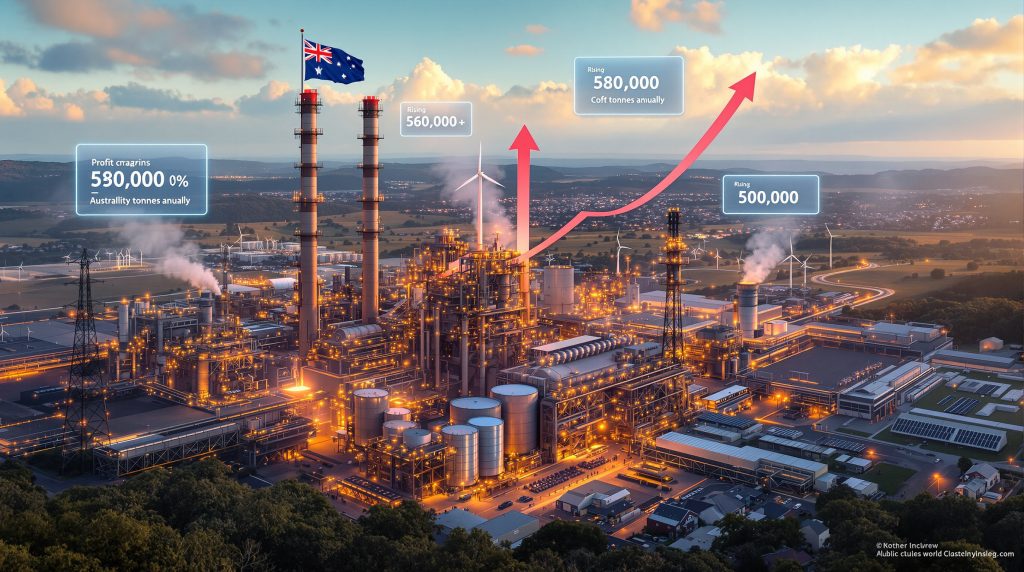Why Is Tomago Aluminium Facing Closure Risk in 2025?
Australia's largest aluminium smelting facility, Tomago Aluminium, is now at significant Tomago Aluminium closure risk due to unsustainable energy costs. As negotiations continue with government and industry stakeholders, the outcome will not only determine the fate of a major manufacturing employer but also send ripples throughout the nation's industrial landscape. Furthermore, this situation highlights the broader energy export challenges facing Australian heavy industry.
What Makes Tomago Aluminium Critical to Australia's Economy?
Located in the Hunter Valley, Tomago Aluminium is a backbone of the Australian manufacturing sector. This expansive operation processes close to 40% of the country's total aluminium output, underlining its strategic importance.
Key Economic Indicators:
- Annual aluminium production capacity: 590,000 tonnes
- Employs over 1,000 highly trained staff
- Accounts for approximately 40% of Australia's entire aluminium market
- Roughly 90% of its output is exported across the Asia-Pacific, supporting Australia's balance of trade
Tomago is not just an industrial giant in production; it anchors a broad network of supply chain partners, export logistics, and local service businesses. The economic activity driven by Tomago underpins thousands of additional jobs and feeds into state and national revenues.
How Do Energy Costs Impact Aluminium Smelting Operations?
Aluminium smelting stands among the most energy-intensive industrial processes globally. The core technology, electrolytic reduction, requires an uninterrupted, high-density electricity supply. This dependency means operational costs are uniquely tied to the electricity market, particularly affecting the Tomago Aluminium closure risk.
Energy Consumption Profile:
| Cost Component | Percentage of Operations |
|---|---|
| Electricity costs | 40%+ |
| Raw materials | 25-30% |
| Labor and overhead | 20-25% |
| Other operational costs | 10-15% |
Tomago Aluminium is the single largest electricity consumer in Australia, drawing power comparable to a medium-sized city. According to company statements, its power bills make up over 40% of total operating costs, far exceeding typical ratios for other manufacturing industries.
Fluctuations in wholesale electricity prices—compounded by increased costs of both coal-fired and renewable energy—now threaten to push Tomago's expenses beyond sustainable limits by the end of its current supply contracts. In addition, the development of renewable energy solutions remains critical for long-term viability.
Energy-intensive plants like Tomago require not just high capacity, but stable 24/7 supply to prevent catastrophic equipment damage and costly restarts. This condition severely limits their flexibility in seeking short-term or intermittent power solutions.
What Factors Drive the 2028 Closure Timeline?
Tomago Aluminium's immediate future depends on its long-term electricity contract, which locks in pricing stability until 2028. After this date, all options currently available in the market are forecast to be prohibitive, substantially increasing the Tomago Aluminium closure risk.
Timeline Breakdown:
- 2025–2027: Operations continue under existing contracts and ongoing consultations with government and workforce
- 2028: Expiry of Tomago's primary energy contract; future viability depends on securing new terms
- 2029 and beyond: Projected spike in electricity costs; industry analysis suggests these increases will render the smelter unviable without intervention
Crucially, multiple energy market soundings since 2022, as well as months of negotiation with government and energy providers, have yet to produce a competitive solution. The uncertainty is already weighing on the more than 1,000 workers at the facility.
Which Stakeholders Are Involved in Potential Solutions?
The uncertainty surrounding Tomago's future has drawn in a wide web of stakeholders, each with unique interests and influences on the pending decision. However, the complexity requires government intervention strategies to address the mounting challenges.
Primary Stakeholders:
- Rio Tinto: Holds majority ownership and ultimate authority over capital allocation decisions
- Federal Government: Responsible for nationwide manufacturing policy, energy security, and trade competitiveness
- NSW State Government: Addresses regional economic development, employment, and energy infrastructure planning
- Australian Manufacturing Workers' Union: Represents the interests and rights of over 1,000 employees and their families
- Hunter Valley Communities: Reliant on the economic activity, public services, and infrastructure supported by Tomago's operations
Active negotiations are ongoing, with the company seeking government intervention or structured support in the form of subsidised energy rates or direct assistance programs. For instance, the potential closure has prompted extensive consultations between Rio Tinto and its workforce.
How Do Government Bailout Precedents Apply?
Australian governments have stepped in before to safeguard strategically important smelting facilities. These rescue packages set benchmarks for the scale and form of possible intervention at Tomago.
Bailout Comparison Analysis:
| Facility | Support Package | Outcome |
|---|---|---|
| Queensland Mount Isa | $600 million | Operational continuity |
| Tomago (potential) | $1+ billion est. | Under negotiation |
| Industry average | $400–800 million | Mixed results |
Support can include direct subsidies, energy rate caps, or underwriting renewable project development. However, such packages face legal hurdles under international trade agreements and intense public scrutiny regarding the best use of taxpayer funds.
Any government package at Tomago is likely to require robust justification of long-term economic benefits, as well as transitional plans for workers and the wider Hunter community.
What Are the Regional Economic Consequences?
A closure at Tomago would have immediate, severe, and cascading effects on the Hunter Valley economy and beyond. Furthermore, addressing the Tomago Aluminium closure risk requires understanding these broader implications.
Economic Impact Assessment:
- Direct job losses: More than 1,000 skilled positions at the smelter
- Indirect employment: Estimated 2,000–3,000 supply chain and service sector roles at risk
- Regional GDP loss: Over $500 million annually in direct and indirect activity
- Tax revenue reduction: Significant falls in federal and state revenue streams due to lost wages, payroll, and corporate taxes
- Community services: Reduced funding capacity for infrastructure, education, and healthcare in a region already exposed to industrial transition
The uncertainty has profound effects on the morale and planning of the workforce, with union representatives highlighting the psychological burden placed on local families. Consequently, news outlets including the ABC have extensively covered the potential impact on jobs and the local community.
How Does This Affect Australia's Manufacturing Strategy?
The closure risk crystallises broader concerns about the resilience and competitiveness of Australian heavy industry in an era of rising energy prices. In addition, this situation reflects wider industry innovation trends affecting manufacturing competitiveness.
Strategic Considerations:
- Import dependency: Without Tomago, Australia could face increased exposure to global aluminium price swings and potential supply disruptions
- Supply chain security: Weakening of domestic metals production erodes the ability to sustain advanced manufacturing and defense sectors
- Industrial expertise: Closure means the loss of generations of expertise in aluminium smelting, harder to restart or replace later
- Export earnings: A dramatic slump in Australia's aluminium exports threatens the current balance of trade with key Asian partners
Policy-makers face a critical inflection point: whether to directly support legacy industries through market shocks, or pivot to alternative high-value sectors.
What Renewable Energy Solutions Could Preserve Operations?
A shift to renewable energy is often cited as a long-term route to stabilising costs and emissions. For Tomago, the challenge lies in scale and timing, particularly when considering decarbonisation benefits for heavy industry.
Renewable Energy Requirements:
- Industrial-scale delivery: Tomago requires power capacity equal to a substantial renewable energy development, not yet online
- Continuous, stable supply: Smelters demand 24/7 baseload power, often difficult to guarantee from wind and solar without advanced storage solutions
- Cost parity: New renewable contracts must match or better today's electricity costs to be feasible
- Lead times: Developing the needed infrastructure, such as battery storage or new grid connections, typically exceeds five years — beyond the 2028 deadline
At present, neither the timeline for major renewable projects nor their anticipated pricing fully aligns with Tomago's urgent requirements, highlighting a gap between policy ambition and practical delivery.
Which Alternative Scenarios Could Emerge?
Given the complexity of energy pricing, investment, and policy, a range of scenarios exist for Tomago Aluminium post-2028.
Potential Outcomes:
- Full bailout package: Joint government and company investments could secure operation under revised energy contracts
- Partial downsizing: The smelter could reduce capacity and workforce, preserving core roles while awaiting longer-term renewable solutions
- Gradual closure: A phased approach could allow for retraining programs, regional diversification, and infrastructure redevelopment
- Private sector solution: Acquisition, joint ventures, or public-private partnerships might open alternative funding, provided energy pricing gaps close
- Complete shutdown: Without intervention, operations could cease suddenly post-2028, triggering all outlined economic consequences
The outcome will depend on ongoing discussions between company leadership, government, and worker representatives, as well as future energy market evolution.
What Does This Mean for Australian Manufacturing?
The crisis is emblematic of structural vulnerabilities in Australian heavy manufacturing. How stakeholders respond will influence both national policy and investor perceptions for years to come.
Key Takeaways:
- Effective energy cost management is vital for Australia's industrial competitiveness
- Government action may be required to bridge the gap between current market realities and national manufacturing ambitions
- Regional planning must anticipate both the risks of industrial decline and the opportunities in transitional economies
- Accelerated renewable energy investments are needed, but must be matched with industrial reliability and affordability timelines
Disclaimer: Forecasts and scenarios discussed in this article involve significant uncertainty and should not be relied upon as definitive predictions. Decisions on industrial policy, energy pricing, and facility investments depend on evolving market, regulatory, and stakeholder dynamics.
Ready to Discover the Next Major Industrial Investment Opportunity?
As Australia's industrial landscape faces unprecedented challenges like those at Tomago Aluminium, smart investors are positioning themselves to capitalise on emerging opportunities in the resource sector. Discovery Alert's proprietary Discovery IQ model delivers real-time alerts on significant ASX mineral discoveries, transforming complex market data into actionable insights for both short-term traders and long-term investors seeking the next breakthrough opportunity.




